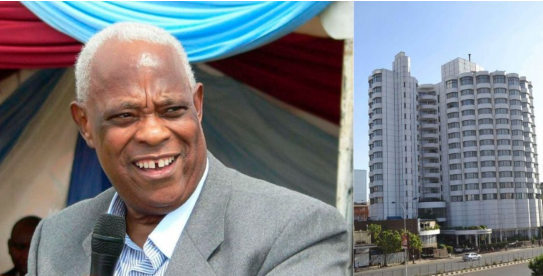Before he left for Tel Aviv, Israel, Jewish real estate developer Joseph Goldberger was taught a painful lesson by the master of looting hive.
By the time Githunguri died last week, the story of how he messed up planned housing in Nairobi’s Tena and Donholm estates had
largely been forgotten.
But it is a story well known in the circles of “old money” – after
Goldberger sought justice over a Sh50 million swindle, the case was
heard on camera.
Apparently, Githunguri, unwilling to have the scandal publicised,
told the judge that some of the evidence he was about to give
touched on “national security”.
It was a lie, but Justice Simpson only realised later that Githunguri
had duped him.
So famous was the Israeli millionaire in Nairobi’s Jewish circles that
his memory is etched on a stained glass window at the city’s Jewish
synagogue, donated by his family to celebrate his legacy. In
Nairobi’s Industrial Area, the family ran an engineering firm, East
African Hydraulic and Metal Industries Limited.
Read: Pastor named in Sh90m church land sale dispute
By acquiring more than 900 acres of modern-day Donholm, Tena,
Savannah, Greenfields and Tassia estates from the estate of James
Kerr Watson, the Israeli co-opted politicians out to get a slice of the
land. By doing this, he thought he was secure.
Goldberger’s Continental Developers Limited was registered in
1973, with a nominal share capital of Sh200,000. The tycoon had
listed the company’s head office as LR 209/4390 along Dar es
Salaam Road, which also housed his engineering firm.
To protect himself, Goldberger had listed President Jomo Kenyatta’s
daughter Margaret, Dr Njoroge Mungai (Kenyatta’s first cousin) and
Harun Muturi (Kenyatta’s in-law) as co-directors.
Before Githunguri threw him into financial turmoil, Goldberger
had first developed Old Donholm and had started developing
Mountain View estate. Then, he ran out of cash and decided to sell
some plots on the expansive Donholm farm.
First, Goldberger subdivided 98 acres of modern-day Tena estate
into 900 plots after Teachers of Nairobi (Tena) Sacco agreed to
purchase them for its members. In the initial arrangement,
Continental was to design the houses to maintain a look similar to
the neighbouring Buruburu. Goldberger’s dream was to have an
organised Eastlands with laid-out infrastructure.
Read: Githunguri, the banker who had President’s ear
To raise money, Yoji, as Goldenberg was known in Nairobi, sold the
Old Donholm shopping centre to Ignatius Nderi, the director of the
Criminal Investigations Department. He then sold some land to a
It was during this period that Goldberger, known for his deep love
for classical music, was introduced to the man who would change
his life – the executive chairman of the National Bank of Kenya
(NBK), Githunguri, the president’s banker.
While Muturi was Continental’s managing director, the man who
ran the show was Goldberger – after all, he was the main
shareholder. So Muturi would sign the chequebook leaves and
leave them with Goldenberger.
Court records indicate that on November 19, 1976, Goldberger and
Muturi went to see Githunguri and they executed a debenture, or
rather signed a loan of Sh10 million from NBK to develop
Donholm estate houses. That was the first loan.
would give rise to the land chaos in Tassia estate, Nairobi.
As the High Court would later find out, Githunguri intended to
defraud NBK with that Tassia land.
To do that, Githunguri had organised to have Continental build
some 814 houses for Sh164 million on the Tassia land, which he
now owned.
NBK had agreed to advance Sh85 million to Goldberger’s company
while the balance would be paid on completion and after
production of the occupation certificate. Interestingly, the bank was
to purchase all the houses for its employees after completion. As
the paperwork was being done, Kenyatta died in August 1978,
throwing most of his loyalists off-balance.
Resolution
Continental’s directors then passed a resolution to borrow some
Sh85 million from NBK – some three days after Kenyatta was
buried. That resolution was signed by Goldberger and Muturi on
November 3, 1978 as the chairman and managing director,
respectively. They then took it to NBK headquarters where they
signed a personal guarantee of up to Sh85 million.
Read: Former MP and estate agent in row over Sh79m
On November 9, 1978, Goldberger and Muturi received a letter,
Ref.AKN/vmm/11/6678 from AN Ngwiri, a chief branch manager
at NBK’s Harambee Avenue branch, confirming that the
headquarters had authorised a loan of Sh80 million, “bringing the
total indebtedness to us to Sh83,032,116”.
With that letter, Goldberger was asked to execute a first legal charge
for Sh80 million over the 900 acres on LR No 212/3, which is the
In another paragraph, Goldberger was told that the whole amount
owed must be liquidated within two years from the sale proceeds of
the Donholm houses. That letter was copied to M/s Waruhiu and
Muite advocates representing the bank.
What was not being said was that the Donholm houses were on
land already owned by the bank’s executive chairman. In essence,
NBK was financing a developer to build houses on land owned by
its executive chairman and then buy back the complete houses,
ostensibly from the developer, but in essence, it was Githunguri
who would earn the profits.
During the court hearing that followed, Justice Simpson remarked
that “there was a great deal that (Githunguri) did not wish to
disclose”, perhaps the reason why the matter was heard on camera.
Sh50 million from the loan account as he promised to bank it in an
interest-earning account. They then signed what became known as
“NBK Donholm House Scheme”. Tassia, as per the records, was not
featured in the scheme. It was their secret.
Goldberger told the court that Githunguri asked him to return to
his NBK office with the company’s cheque book. He went
accompanied by a Mr Benjamin, his manager. As he told Justice
Simpson, Githunguri asked him to write two cheques for Sh15
million and Sh20 million in favour of a Ms Njeri Njoroge and
another cheque of Sh15 million in the name of Jenkinson & Parekh,
a company that had been mentioned adversely in the 1966 maize
scandal involving Cabinet Minister Paul Ngei’s wife Emma.
During the in-camera hearings, Githunguri denied giving such
instructions or offering to place the Sh50 million in an interestearning deposit account. But the court found Githunguri’s initials
on each of the cheques and wondered whether he was truthful
given that he had “evasively denied any connection with Tassia
Coffee Estate”, in which he then owned a 90 per cent stake.
Justice Simpson was at a loss: “I find it very difficult to believe that
Mr Goldberger and Mr Muturi would pay out Sh50 million to
strangers merely on a verbal promise by the executive chairman of
the bank. However, I have no doubt that Mr Githunguri did indeed
ask that the cheques be made out in the names of the two payees.”
Was NBK liable? Justice Simpson thought that Githunguri asked
for these transfers in his private capacity.
“I do not believe he was acting as executive chairman of the bank,
nor do I believe that either Mr Goldberger or Mr Muturi thought he
was so acting,” he said.
After Githunguri was removed from the bank in 1980, Muturi
decided to follow up on the Sh50 million deposit with a letter dated
February 26, 1980. He thought it would still be intact. However,
after discussions with the managing director, Mr JAC Smith, he
realised there was no such account.
Muturi realised that Continental was paying interest on a Sh50
million facility that it could not access – and NBK was deducting
the money from its current account.
Ballooned
Meanwhile, the bank started demanding that Continental repays
the loan advanced to it – including the Sh50 million. This
ballooned to Sh127 million.
“It follows that (Continental Developers) owes money to National
Bank and National Bank owes no money to Continental,” ruled
Justice Simpson.
As the NBK project collapsed, the ruins were legally on land owned
by Githunguri.
As auctioneers descended on his estate, he tried to salvage part of
the land, now Tena estate. One of former President Daniel Moi’s
sons, Raymond, had agreed to develop some 88 bungalows. But
Raymond ran short of cash and Goldberger took over the project.
rise – he started developing Lilian Towers in the early 1980s. He
found peace within Nairobi’s Freemason Lodge, while Muturi went
for the bottle. He would later find solace in building Nairobi’s
Mamba Village.
Finally, Goldberger, who never built a house for himself, left his
Sh50,000 a month rented house in Riverside for Israel.
Tena, his dream scheme, saw new developers build uncoordinated
houses. As a result, only Goldberger’s road network remained
intact, and the face of Eastlands was forever changed.



